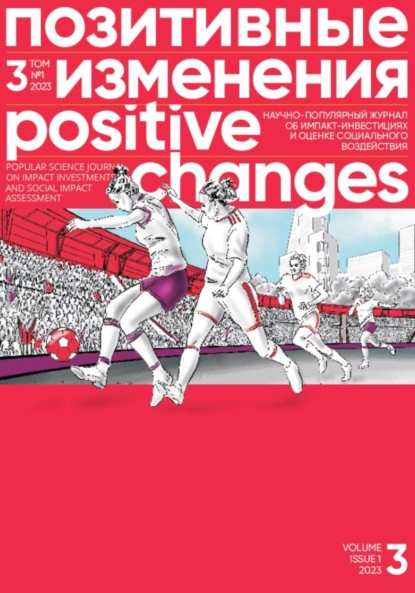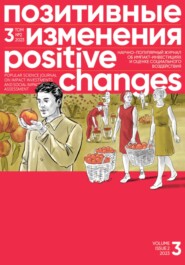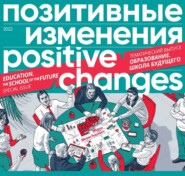По всем вопросам обращайтесь на: info@litportal.ru
(©) 2003-2024.
✖
Позитивные изменения, Том 3 №1, 2023. Positive changes. Volume 3, Issue 1 (2023)
Настройки чтения
Размер шрифта
Высота строк
Поля
THE KEY AREAS OF IMPROVEMENT OF THE RUSSIAN MECHANISM FOR ASSESSING THE ACTUAL IMPACT IN SOCIAL INVESTMENT
When discussing the Russian experience of social investment, it is worth focusing on three ways in which they can be legally formalized:
• social impact projects;
• the status of a social entrepreneur;
• public-private partnerships for investment projects to establish social institutions.
In Russia, experts call one of the legislative initiatives to introduce social investments a pilot testing of social impact bonds (SIB). Within the corresponding state program[47 - Resolution of the Government of the Russian Federation No.1491 of 21 November 2019 “On the Organization of Pilot Testing of Social Impact Projects by the Constituent Entities of the Russian Federation in 2019–2024.], funds are raised from investors to finance social projects. The costs will be later compensated by the state if the projects successfully achieve the intended social impact.
The second tool being considered for the legal registration of social investment in Russia is the status of a social entrepreneur. A review of the existing benefits of social entrepreneur status examines the set of benefits conferred by this status (Umnov, Plyukhina & Matveev, 2018). In particular, the Tax Code of the Russian Federation establishes a preferential tax regime for organizations that carry out socially beneficial activities (exemption from value added tax or profit tax in different areas of activity). Social entrepreneurs are in the focus of a number of government programs (such as the “Social Support for Citizens” program), which are created specifically so that social entrepreneurs can be engaged in their implementation. In the final part of the article, the authors consider the peculiarities of the Russian social entrepreneur’s status in great detail, as one of the key areas for improvement.
The third way to legally formalize social investment is public-private partnership for the development of social infrastructure. Andrey Bednyakov, an expert at the National Center for Public-Private Partnerships and the Rosinfra platform, points out that only 8 % of the funding in Russian PPP projects go to the social sector (Bednyakov, 2022). At the same time, the share of private investment into infrastructure in Russia is 2 % of the total volume. He draws a general conclusion about the low evolutionary state of the respective development institutions, as well as the lack of an effective regulatory system in the form of transparent competitive procedures. The lack of an effective project evaluation methodology (for example, such efficiency metrics as Return on Investment are seldom used) can be identified as a fundamental quality of the Russian case. In contrast, the expert cites Canada, where PPP projects are legally required to have an evaluation methodology and an independent evaluator. The importance of metrics for the development of social investment will also be discussed below.
One major difference between social investment and mere charity is the mandatory measurement of the social results achieved.
One major difference between social investment and mere charity is the mandatory measurement of the social results achieved. This condition is used in a small share of publicly funded social projects. In particular, neither the status of a social entrepreneur, nor the public-private partnership mechanism for support of investment projects to create social institutions involves measuring social impact. This is the main disadvantage of the current mechanisms.
Social investment can be defined as investing into a positive social result. If an entrepreneur invests money and expects to generate revenue or even profit (as in the case of public-private partnerships), this is not social investment, but rather traditional commercial investment in the social sector. Social investment is different from investment in that the returns are not primarily economic but social, which must be proven through the assessment of social impact of the project. The absence of an evaluation mechanism creates a confusion between impact investment and commercial investment, as is the case in the Russian models of social entrepreneurship and public-private partnerships.
According to current legislation, these models interpret the very fact of working in the social sphere as, first, a socially oriented activity, and second, a successful activity. Turning to the Federal Law No. 245-FZ of 26 July 2019 “On Amendments to the Federal Law On the Development of Small and Medium Entrepreneurship in the Russian Federation”, which defines the concepts of “social entrepreneurship” and “social enterprise”, you can see that inclusion in the register of social entrepreneurs is possible on several equally important grounds.
Some of the attributes are of a substantive and judgmental nature – for example, providing employment to people from socially vulnerable categories[48 - According to paragraph 1 of Article 241, these categories include persons with disabilities, single parents or parents with many children, senior citizens and people of preretirement age, orphanage graduates, refugees, indigent people, homeless persons and persons without a definite place of residence and occupation.], facilitating the sale of products produced by such workers, or producing the goods for socially vulnerable groups. It is true that any activity in this area would have above-zero social effect per se, but the question of its effectiveness would remain. On the other hand, the criteria used for including most businesses in the register, specify the areas of operations that automatically make your enterprise a social one. For example, these areas include services in the field of additional education, recreation and health improvement for children, cultural and educational activities. In this case social impact cannot even be confidently stated without further evaluation.
Since social investment requires proof of social impact, it seems reasonable to consider including the requirement for evaluation into the legislation. In particular, to introduce practices of social impact assessment for inclusion in the register of social entrepreneurs or confirmation of the status of a social enterprise. This way the legislative environment will stimulate a more informed and evidence-based approach to social investment using social entrepreneurship as an example.
Going back to the report by the European Parliament’s Policy Department for Economic, Scientific and Quality of Life Policies (Mackeviciute, R. et al., 2020) with an overview of best practices in social investment, we must mention that most of the measures listed in the report have been adopted in Russia, with varying degrees of success:
• creation of state structures responsible for the facilitation of the impact investment market (VEB.RF as the SIB project operator);
• providing a legal framework and legal status for social entrepreneurs;
• availability of tax incentives.
However, at the moment, with the exception of the SIB project mechanism itself, there are no regulatory measures – particularly in the form of the introduction of standardized systems for measuring social impact and reporting. It is this indispensable element of the legal foundation of social investment that is proposed for implementation in the Russian context.
Similar practices of social impact assessment are important in other Russian legal constructs in the field of social investment – such as public-private partnership projects, which do not currently undergo social impact assessment, or the social impact bonds projects, which need a mediator to evaluate the project results.
To summarize, it must be said that actual impact assessment in the field of social investment both in Russia and abroad, being an integral element of the definition of this type of investment, is gradually beginning to take shape in both practice and legislation.
REFERENCES
1. Mackeviciute, R., Martinaitis, Z., Lipparini, F., Scheck, B. C., & Styczynska, I. (2020). Social Impact Investment – Best Practices and Recommendations for the Next Generation. Policy Department for Economic, Scientific and Quality of Life Policies Directorate-General for Internal Policies, European Parliament. Retrieved from: https://www. europarl.europa.eu/RegData/etudes/STUD/2020/658185/ IPOL_STU(2020)658185_EN.pdf. (accessed 07.02.2023).
2. Alekseeva, M. (2017). Monitoring in the Framework of the Institutions of Regulatory Impact Assessment and Evaluation of Actual Exposure in Russian Federation. State and Municipal Administration. Scientific Notes, (2), 20–25. https://doi.org/10.22394/2079–1690–2017–1–2–20–25.
3. Arzamasov, Yu. G. (2019). Regulatory Impact Assessment and Risks in Law: Experience of Russia and Continental Europe. Pravo. Zhurnal Vysshey shkoly ekonomiki, (S5), 4–31. http://doi.org/10.17323/2072–8166.2019.5.4.31.
4. Bednyakov, A. S. (2022). Public-Private Partnership as a Model of Public Infrastructure Development. MGIMO Review of International Relations, 15 (1), 143–176. https:// doi.org/10.24833/2071–8160–2022–1–82–143–173.
5. Golodnikova, A. & Tsygankov, D. (2015). Regulatory Impact Assessment Targeting: International Approaches and Russian Experience. Public Administration Issues, (4), 7–40.
6. Golodnikova, A., Efremov, A., Sobol, D., Tsygankov, D., & Shklyaruk, M. (2018). Regulatory Policy in Russia: Key Trends and the Architecture of the Future Center for Strategic Research (CSR) Reports, (1), 1–191.
7. Ivanova, N. (2020). Social Impact Investments: International Experience. Information and analytical bulletin on the development of the civil society and the nonprofit sector in Russia. 1(18).
8. Kwon, G. (2020). Assessing the Social Impact of Transformative Investment: Issues and Approaches. Bulletin of Economics, Law and Sociology, (4), 24–28.
9. Orekhova, N. (2022). Assessment of the Regulatory and Actual Impact of Statutory Regulations: International Experience and Prospects in Russia. Legal Science, (11), 169–175.
10. Umnov, V., Plyukhina, A., & Matveev, M. (2018). Analysis of the State Support System for Social Entrepreneurship in Russia. Bulletin of the Russian State University of Humanities. “Economics. Management. Law” series, (3 (13)), 77–89. https://doi.org/10.28995/2073–6304–2018–3–77–89.
Кейс выпуска / The Case of the Issue
Как устроен лучший грантовый конкурс социальных проектов 2022 года. Опыт фонда «Дорога к дому»
В 2022 году грантовый конкурс Благотворительного фонда «Дорога к дому» был признан лучшей программой, способствующей устойчивому развитию с помощью конкурсных механизмов. Он одержал победу в проекте Форума Доноров «Лидеры корпоративной благотворительности». В номинации «Лучший грантовый конкурс» соревновались 12 заявок. Рассказываем в нашем материале, как проходит конкурс социальных проектов и что помогло ему завоевать признание профессионального сообщества.
Алена Богомолова
Руководитель ресурсно-методического центра Благотворительного фонда «Дорога к дому», член правления Ассоциации специалистов по оценке программ и политик
ОТ ОДНОГО ПРОЕКТА К СИСТЕМНОЙ ПОМОЩИ
Благотворительный фонд «Дорога к дому» был основан в 2005 году как корпоративный фонд компании «Северсталь» по личной инициативе бизнесмена Алексея Мордашова в городе Череповец Вологодской области. Его работа началась с одного проекта по содействию семейному устройству детей-сирот и детей, оставшихся без попечения родителей. Постепенно круг деятельности фонда расширялся: появились проекты по профилактике отказов от новорожденных, по работе с трудными подростками и семьями группы риска, где по причинам семейного неблагополучия родителей могут ограничить или лишить родительских прав.
18 февраля 2023 года фонд «Дорога к дому» отметил свое 18-летие. За эти годы он реализовал десятки проектов, благодаря которым ежегодно получают помощь специалистов 15–20 тысяч человек, в Череповце в 7 раз снизилось количество отказов от новорожденных детей, около 200 младенцев остались в кровных семьях, а за последние четыре года в Вологодской области в 3 раза снизилось количество семей, находящихся в социально опасном положении, и в 2,4 раза снизилось количество преступлений, совершаемых подростками. Сегодня фонд – это крупнейшая некоммерческая организация Вологодской области и ресурсный центр для специалистов НКО со всей России.
Фонд занимается развитием системной благотворительности. Его работа направлена на эффективное решение социальных проблем, актуальных для семей с детьми. Чтобы узнать, какие вопросы волнуют семьи и определить перечень основных направлений деятельности, организация проводит прикладные исследования. Дальнейшая задача – поддержать лучшие практики, инструменты и технологии помощи семьям и детям. С этой целью фонд проводит грантовый конкурс социальных проектов. Принять участие в нем могут НКО и учреждения социальной сферы. Проектные идеи оценивают независимые эксперты. Учитывается, прежде всего, отсутствие дублирования с текущей деятельностью организации-заявителя, достижимость обозначенных целей и задач, актуальность проекта для целевой группы и сообщества, логическая связность проектов.
Конкурс социальных проектов стал инструментом улучшения качества жизни граждан на территориях его проведения. Его финансирование «Северсталь» рассматривает как социальные инвестиции и вклад в достижение Целей устойчивого развития ООН: ЦУР 3 «Хорошее здоровье и благополучие», ЦУР 10 «Уменьшение неравенства», ЦУР 4 «Качественное образование», ЦУР 17 «Партнерство в интересах устойчивого развития» и др.
Конкурс способствует реализации целей стратегии устойчивого развития[49 - Северсталь. (2023). Содействие развитию регионов и сообществ. Режим доступа: https://severstal.com/rus/sustainable-development/social/community/. (дата доступа: 01.03.2023).] и корпоративной благотворительности компании, а также государственной политики в области семьи, материнства и детства.
ТЕРРИТОРИАЛЬНЫЙ ОХВАТ
С 2008 до 2011 гг. грантовый конкурс проводился в Череповце. Сегодня география конкурса соответствует территориям присутствия компании «Северсталь».
В 2012 году были впервые включены города:
• Воркута (Республика Коми);
• Великий Устюг (Вологодская область);
• Балаково (Саратовская область);
• Костомукша (Республика Карелия).














